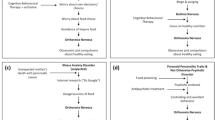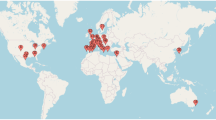Abstract
Aim
To review the literature on the prevalence, risk groups and risk factors of the alleged eating disorder orthorexia nervosa.
Methods
We searched Medline and Pubmed using several key terms relating to orthorexia nervosa (ON) and checked the reference list of the articles that we found. Attention was given to methodological problems in these studies, such as the use of non-validated assessment instruments, small sample size and sample characteristics, which make generalization of the results impossible.
Results
Eleven studies were found. The average prevalence rate for orthorexia was 6.9 % for the general population and 35–57.8 % for high-risk groups (healthcare professionals, artists). Dieticians and other healthcare professionals are at high risk of ON. Risk factors include obsessive–compulsive features, eating-related disturbances and higher socioeconomic status. Relevant clinical experience, published literature and research data have increased in the last few years.
Discussion
The definition and diagnostic criteria of ON remain unclear. Further studies are needed to clarify appropriate diagnostic methods and the place of ON among psychopathological categories.
Similar content being viewed by others
References
Russell G (1979) Bulimia nervosa: an ominous variant of anorexia nervosa. Psychol Med 9:429–448
Keel PK, Heatherton TF, Dorer DJ, Joiner TE, Zalta AK (2006) Point prevalence of bulimia nervosa in 1982, 1992, and 2002. Psychol Med 36:119–127
Spitzer RL, Devlin M, Walsh BT, Hasin D, Wing R, Marcus M, Stunkard A, Wadden T, Yanovski S, Agras S, Mitchell J, Nonas C (1992) Binge eating disorder: a multisite field trial of the diagnostic criteria. Int J Eat Disord 11(3):191–203
Bratman S (1997) Orthorexia nervosa. Yoga J. http://www.orthorexia.com/index.php?page=essay
Bratman S, Knight D (2000) Health food junkies: overcoming the obsession with healthful eating. Broadway Books, New York
Swain PI (2005) Trends in eating disorders research. Nova Publishers, Hauppauge
Mathieu J (2005) What is orthorexia? J Am Diet Assoc 105(10):1510–1512
Rössner S (2004) Orthorexia nervosa—a new disease? Lakartidningen 101(37):2835
Dudás K, Túry F (2008) Orthorexia nervosa: az egészségesétel-függőség, mint a legújabb evészavarok egyike. Mentálhigiéné és Pszichoszomatika 9:125–137
Bartrina JA (2007) Orthorexia or when a healthy diet becomes an obsession. Arch Latinoam Nutr 57(4):313–315
Varga M, Dudás K, Túry F (2010) Az orthorexia nervosa—egészségesétel-függőség. In: Kun B (ed) Demetrovics Zs. Budapest, Az addiktológiai alapjai IV. Viselkedési függőségek. ELTE Eötvös Kiadó, pp 447–458
Cartwright MM (2004) Eating disorder emergencies: understanding the medical complexities of the hospitalized eating disordered patient. Crit Care Nurs Clin N Am 16(4):515–530
Catalina Zamora ML, Bote Bonaechea B, García Sánchez F, Ríos Rial B (2005) Orthorexia nervosa. A new eating behavior disorder? Actas Esp Psiquiatr 33(1):66–8
Paraschakis A (2007) Psychiatric disorders of the developed world: the case of orthorexia nervosa. Encepha-los 44:46–49
Donini LM, Marsili D, Graziani MP, Imbriale M, Cannella C (2004) Orthorexia nervosa: a preliminary study with a proposal for diagnosis and an attempt to measure the dimension of the phenomenon. Eat Weight Disord 9(2):151–157
Kinzl JF, Hauer, K, Traweger, Ch, Kiefer I. Orthorexia nervosa: Eine häufige Essstörung bei Diätassistentinnen? Ernährungs-Umschau 2005; 52(11)
Kinzl JF, Hauer K, Traweger CH, Kiefer I (2006) Orthorexia nervosa in dieticians. Psychother Psychosom 75:395–396
Bağci Bosi AT, Camur D, Güler C (2007) Prevalence of orthorexia nervosa in resident medical doctors in the faculty of medicine (Ankara, Turkey). Appetite 49(3):661–666
Eriksson L, Baigi A, Marklund B, Lindgren EC (2008) Social physique anxiety and sociocultural attitudes toward appearance impact on orthorexia test in fitness participants. Scand J Med Sci Sports 18(3):389–394
Arusoğlu G, Kabakçi E, Köksal G, Merdol TK (2008) Orthorexia nervosa and adaptation of ORTO-11 into Turkish. Turk Psikiyatri Derg 19(3):283–291
Aksoydan E, Camci N (2009) Prevalence of orthorexia nervosa among Turkish performance artists. Eat Weight Disord 14(1):33–37
Korinth A, Schiess S, Westenhoefer J (2010) Eating behaviour and eating disorders in students of nutrition sciences. Public Health Nutr 13(1):32–37
Fidan T, Ertekin V, Işikay S, Kirpinar I (2010) Prevalence of orthorexia among medical students in Erzurum, Turkey. Compr Psychiatry 51(1):49–54
Ramacciotti CE, Perrone P, Burgalassi A, Conversano C, Massimetti G, Dell’Osso L (2011) Orthorexia nervosa in the general population: a preliminary screening using a self-administered questionnaire (ORTO-15). Eating Weight Disord 16:127–130
Varga M, Máté G (2010) Eating disturbances in orthorexia nervosa. XIII. Annual meeting of the European Association for Consultation-Liason Psychiatry and psychosomatics EACLPP) XVIII. European Conference of Psychosomatic Research (ECPR): a selection of the best abstracts submitted. J Psychosom Res 68:672–673
Donini LM, Marsili D, Graziani MP, Imbriale M, Cannella C (2005) Orthorexia nervosa: validation of a diagnosis questionnaire. Eat Weight Disord 10(2):28–32
Vandereycken W (2011) Media hype, diagnostic fad or genuine disorder? Professionals’ opinions about night eating syndrome, orthorexia, muscle dysmorphia, and emetophobia. Eat Disord 19(2):145–155
Molina Alén E (2006) “Perspectiva antropológica de un caso de ortorexia nerviosa”. Cultura de los cuidados. Año 10(20):109–116
Shelton NJ (2007) What not to eat: inequalities in healthy eating behaviour, evidence from the 1998 Scottish Health Survey. J Public Health 27(1):36–44
American Psychiatric Association (1987) Diagnostic and statistical manual of mental disorders. American Psychiatric Association, Washington, DC
Golan M, Crow S (2004) Parents are key players in the prevention and treatment of weight-related problems. Nutrition Rev 62(1):39–50
Berghöfer A, Pischon T, Reinhold Th, Apovian CM, Sharma AM, Willich SN (2008) Obesity prevalence from European perspective: a systematic review. BMC Public Health 8:200
Fairburn Ch, Cooper Z (2011) Eating disorders, DSM-5 and clinical reality. Brit J Psychiatry 198:8–10
Conflict of interest
The authors declare that they have no conflict of interest.
Author information
Authors and Affiliations
Corresponding author
Rights and permissions
About this article
Cite this article
Varga, M., Dukay-Szabó, S., Túry, F. et al. Evidence and gaps in the literature on orthorexia nervosa. Eat Weight Disord 18, 103–111 (2013). https://doi.org/10.1007/s40519-013-0026-y
Received:
Accepted:
Published:
Issue Date:
DOI: https://doi.org/10.1007/s40519-013-0026-y




